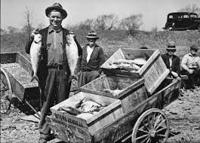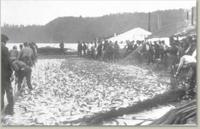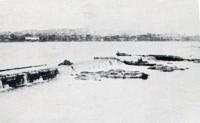For hundreds of years in Lancaster County, one of the most anticipated and important times of the year was when shadbush and bloodroots bloomed.
That was when millions of migratory American shad flooded from the Atlantic Ocean into the Susquehanna River, surging upstream to reproduce in such mass that they pushed the water into waves 3-4 feet high.
For Native Americans and, later, Pennsylvania colonists, shad, or “poor man’s salmon,” delivered a badly needed source of protein and burst of flavor after a long, lean winter. Their roe was considered a delicacy.
For the brief month or so the run lasted, shad were sold throughout Lancaster County in markets and from carts along the river from Columbia to Pequea.

Selling shad along the Susquehanna River.
SUBMITTED PHOTOThe islands and rocks advantageous for catching the millions of shad on their migratory runs became so important during this time that the rights to shad fisheries were used to settle bills and the spots were passed on to sons in wills.
But fighting over the rights to strategic places — and later rancor over the building of dams blocking the great migration — also touched off one of the more violent periods in Lancaster County history.
Mob violence — even murder — followed the arrival of shad from 1738 through the Civil War.
Hollis Bedell, a York County resident and retired college botany professor, recently revisited the troubled times in a presentation, “Trouble on the Susquehanna: The Shad Wars,” during a Susquehanna Heritage talk at the Zimmerman Center for Heritage in Long Level.
Nowhere was the shad run more important or as intensely fished as the section of the river between Columbia and Safe Harbor.
Locals used seine nets, rock fish weirs, gill nets and dip nets to intercept the fish.
Valuable staple
The importance of the Susquehanna’s shad is hard to appreciate today.
Shad became one of Colonial America’s first exports back to Great Britain and Europe. George Washington invested heavily in the shad fishery, using slave labor to catch the fish from his holdings along the Potomac River. Thus, shad are also known as the “founding fish.”
Pennsylvania’s founder, William Penn, in trying to entice British to the New World, extolled the virtues of shad.

A big haul of shad on the Susquehanna River.
U.S. FISH & WILDLIFE SERVICELater, fighting over the shad in Lancaster County and efforts to restore the fish blocked by dams resulted in the formation of the Pennsylvania Fish Commission in 1866.
Tensions rise
In 1731, residents of Manor Township complained to Colonial authorities about a mill dam being built across the Conestoga River, blocking the shad run.
Taking matters into their own hands, neighbors ripped out the dam one night. When it was rebuilt, disgruntled residents tore it down again.
This went on for seven years and finally prompted the first legislation requiring dams to have some means of a fish passage in 1761.
But the law was rarely enforced. By 1775, there was a Fishing Society of Lancaster County, a vigilante group of fishermen who enforced the law themselves.
In 1793, friction over taking fishing rights away from the common man surfaced when the commonwealth settled Revolutionary War debts with veterans by granting them shad-fishing rights to many of the islands in the Susquehanna in Lancaster County.
Matters deteriorated further in 1830 when the first dam across the Susquehanna was built between Columbia and Wrightsville to supply water to the new Susquehanna and Tidewater Canal.

The old Columbia Dam, built in 1830 and the first structure to block the important migration of American shad up the Susquehanna.
SUBMITTED PHOTOAnother canal dam was built near the mouth of the Conestoga at Safe Harbor.
By now, commercial fisheries were firmly established in this section. Groups from the two areas feuded. Each poached on the other’s territory and used fishing techniques that had been outlawed.
They frequently attacked each other’s dams to keep the shad moving.
Murder on the river
In 1862, a group of anglers caught poaching on an island were fired on and one York County resident died on Shad Island in Washington Boro.
Griffin cannons made in Safe Harbor were once used to thwart a raid by the Columbia shad fishers.
Finally, in 1866, the state forced the owners of the Columbia Dam to put in a fish passageway.
But locals, loathe to share their bounty with upriver towns, would plant pieces of moving metal in the water to scare the shad away from the passageways.
The Fish Commission’s first fish wardens were occasionally sent down to quell the violence and stop the illegal activity.
In a well-reported incident documented in local newspapers, five fish wardens sent to Columbia had their boat overturned by locals. When they swam to the Columbia shoreline they were assaulted by residents. They spent the night locked inside a room in a local hotel while an angry mob milled outside, according to Bedell.
After that incident, fish wardens were allowed to carry firearms.
The shad wars only died out after the hydroelectric dam built at Holtwood in 1910 irrevocably blocked upriver migration with a wall of concrete.
Today, despite decades of efforts to restore the shad migration to the Susquehanna through fish lifts over dams and shad stocking, the great runs heralded by spring blooms are but a colorful memory.
However, you can still buy shad locally. Mr. Bill’s Fresh Seafood, for example, sells shad fillets and roe at its store at 430 Harrisburg Pike in Lancaster and at its stand in Central Market from late February until late April or early May.
The shad are caught by commercial fishermen in rivers with shad runs from Georgia to Connecticut. But not from the Susquehanna, where shad are off-limits.
“Back in the day, say 1983, we were buying 1,000 pounds at a shot,” recalls Tim Glatfelter, Mr. Bill’s owner and general manager.
“I would sell all of them. It was all about the taste for people from their childhood.
“It’s kinda sad. There’s fewer and fewer people coming in and telling their stories of going down to the river to catch shad.”
http://lancasteronline.com/news/local/shad-wars-a-long-violent-period-in-lancaster-county-over/article_48c6e18a-3281-11e8-bbdd-c3310badc12c.html
Bagikan Berita Ini















0 Response to "Shad wars: A long, violent period in Lancaster County over a fish in the Susquehanna"
Post a Comment